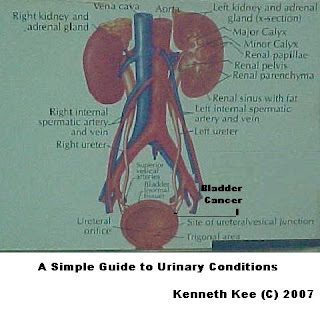
What is Bladder Cancer?
-----------------
Bladder cancer is a growth of abnormal cells forming a malignant tumour in the bladder. Most bladder cancers start in the inner lining of the bladder.
What are the different types of Bladder Cancer?
-----------------------------------------------
There are 2 main types of Bladder Cancer:
1.superficial cancer
the cancer is contained on the inner lining of the bladder.
They may occur as a small, wart-like growths on the inside of the bladder, which can be removed in a simple operation and usually will never recur.
2.invasive cancer
where the cancer has spread into the muscle wall of the bladder.
Examples are:
a.large growth in the muscle wall of the bladder, which requires major surgery to remove.
b.mushroom-like growths( papillary cancers)on the inside lining of the bladder. They have a short stem attached to the lining of the bladder and can spread into the wall of the bladder.
Treatment is different for these two types of bladder cancer.
What are the causes of Bladder Cancer?
-----------------------------------------------
There are a few factors which increase the risk of getting bladder cancer:
1.Smoking
chemicals in a cigarette have been found to contribute to bladder cancer. The more cigarettes smoked, the greater the risk.
2.Exposure to harmful, cancer-causing chemicals
Certain chemicals at the workplace, for example, those used in dye factories, rubber, gasworks, plastics and other chemical industries, can cause a higher risk of contracting bladder cancer in workers.
It can take about 25 years after exposure to these chemicals before bladder cancer develops.These chemicals may have been banned in some countries.
3.Frequent bouts of cystitis
Cystitis caused by repeated bacterial infections and bladder stones can lead to the development of bladder cancer.
4.Age and Gender
Bladder cancer occurs mostly among people aged between 50 - 70 years.
It is twice as common in men as in women.
It is rare in people below age 40.
What are the symptoms of Bladder Cancer?
---------------------------------------------------
The most common symptom is
1.blood in the urine which usually occurs suddenly and is generally not painful.
The blood may not be present constantly but eventually it does recur.
In some cases, blood clots can form and these may cause painful muscle spasms in the bladder. The amount of blood present is however not related to the extent of the cancer.
2. burning feeling when they pass urine.
3. frequency of urination.
While these are also symptoms of bladder irritation, further tests would be necessary if they persist and do not clear with antibiotics.
How can Bladder Cancer be treated?
------------------------------------------
The treatment for bladder cancer depends on the type of cancer, the stage and grade.
It also depends on the health of the patient.
Superficial cancers:
Superficial cancers, which can be single or multiple, are usually removed using a cystoscope. Anti-cancer drugs (chemotherapy or immunotherapy) may be instilled into the bladder to try to prevent the cancer recurring.
Invasive cancers
the options are as follows:
Surgery
The most common treatment method is surgery to remove a part of the bladder.
A new bladder is sometimes constructed if it has to be removed.
Radiotherapy
Radiotherapy may be used instead of surgery to avoid removal of the bladder. Radiotherapy may also be used before surgery in cases of large tumours to facilitate the tumour removal or if there is a high risk of cancer cells left behind after surgery.
Chemotherapy
In some cases, chemotherapy is given before surgery or radiotherapy to shrink the tumour so that it can be treated more effectively. Chemotherapy is also applied after surgery to reduce the recurrence of the tumour.The drug can be instilled into the bladder to maximise contact with the cancer cells.
Once the cancer has spread outside the bladder, the main treatment is chemotherapy.
Removal of bladder
------------------------
In a small proportion of people with bladder cancer, the bladder may completely removed.
The surgeon will then give the patients an urostomy - an artificial opening from the urinary tract.The opening is usually formed on the abdomen, to the right of the navel. Wrinkles, scars and prominent underlying bones must be avoided, as placing the opening near them may cause problems with leakage later on.
Ensure that the bag is emptied and changed as often as necessary.
At first the opening will be slightly swollen.
It may take several weeks for it to reduce to its normal size.
There may also be mucus (a thick white substance) from the opening. The amount of mucus will gradually reduce over time but will never disappear completely.
Most people with an urostomy live a normal life. Many return to their jobs and take up their favourite pastimes again, including swimming.
Now with advancement of plastic surgery a new bladder can be constructed easily and the days of urostomy may be over.





